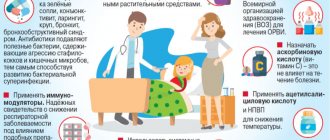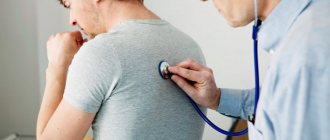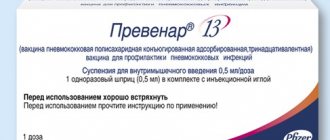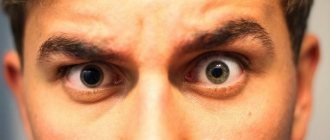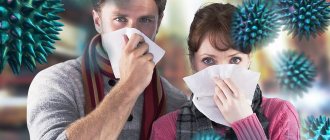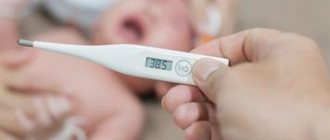Pneumonia is an inflammation of the lungs caused by one or another infectious agent - a virus: coronavirus, adenovirus, etc.
Pathogenic microorganisms enter the human body through airborne droplets or household contact. If a viral infection easily penetrates through the respiratory tract to the lung parenchyma, and the human immune system cannot resist it, an inflammatory process begins, sometimes with complications (pleural effusion, abscess formation, pulmonary fibrosis).
Symptoms and signs
The new coronavirus infection is often accompanied by fever, chills, headache, weakness, loss of smell, sore throat and other symptoms. The disease is not always severe, but it is possible to feel very bad.
Indications for hospitalization
“Patients who test positive for COVID-19 should be hospitalized if:
1. They are in serious or extremely serious condition.
2. Regardless of the severity of the disease, they belong to the risk group (age over 65 years, chronic diseases of the bronchopulmonary, cardiovascular and endocrine systems).
3. Patients belonging to the medical risk group are in a state of mild severity with a decrease in saturation of less than 95%, a persistent increase in body temperature of more than 38 ° C, and increased respiration (more than 22 per minute).
4. Children under 18 years of age are hospitalized for treatment of COVID-19 if one of the criteria is met: T > 39.0°C on the day of admission or T > 38°C for 5 days or more.
5. There are signs of respiratory failure:
- increased breathing;
- dyspnea;
- retraction of the compliant areas of the chest when breathing;
- flaring of the wings of the nose when breathing;
- grunting or groaning breathing;
- respiratory arrest;
- nodding movements of the head, synchronous with inhalation;
- distant wheezing;
- inability to suck/drink due to respiratory problems;
- blueness of the fingers and/or nasolabial triangle;
- oxygen saturation <95%.
6. If any of the following emergency and urgent signs are present:
- convulsions;
- shock;
- severe respiratory failure;
- severe dehydration;
- depression of consciousness (drowsiness) or agitation;
- the appearance of a rash."
Kuldibaeva Alina Talgatovna
expert
If pneumonia develops with COVID-19, the following symptoms may appear or worsen:
- high fever, high fever, or fever with chills;
- frequent breathing or shortness of breath, a feeling that there is not enough air;
- attacks of severe dry cough;
- severe weakness, dizziness;
- pale skin, bluish lips, nails;
- rapid heartbeat².
If a bacterial infection that causes pneumonia is associated with the coronavirus, a dry cough may become wet, with the discharge of thick sputum. You may also experience chest pain that gets worse when you cough or sneeze.
What symptoms require immediate medical attention?
There are several signs of moderate or severe pneumonia:
- respiration rate per minute: 20-30 - moderate severity, more than 30 - severe condition;
- pulse rate per minute at rest: 90-100 - moderate severity, more than 100 - severe condition;
- body temperature: 38-39°C - moderate severity, more than 39°C or less than 35°C - severe condition;
- blood pressure: more than 100/60 mm Hg. Art. - normal or moderate severity, less than 90/60 mmHg. Art. - serious condition;
- saturation 95% or higher is normal or moderate, 94% or lower is severe.
If you have symptoms of severe pneumonia, call emergency medical services. See a doctor immediately if breathing becomes shallow or difficult, there is a feeling of pain or pressure in the chest, there is not enough oxygen, or consciousness becomes confused³.
Anyone infected with coronavirus can develop Covid pneumonia, but the risk is higher for some people. It is mainly associated with age over 65 years, as well as the presence of chronic diseases, reduced immunity, smoking and obesity. If there are such risk factors, it is important to monitor the symptoms of pneumonia especially carefully so as not to miss its development.
With coronavirus, lung damage affects saturation - an indicator characterizing the oxygen saturation of the blood. Saturation is measured with a pulse oximeter, a small sensor that is placed on the tip of your finger. If it decreases, it indicates moderate to severe pneumonia. For moderate pneumonia, saturation is 95% or higher. In severe pneumonia it is below 95%. If the saturation is 94% or lower, the person urgently needs medical attention.
Figure 1. Difference between bacterial and covid pneumonia. Image: felicities/freepik.com
Causes of bacterial pneumonia in adults
Bacterial pneumonia is most often caused by bacteria, which are considered part of the microflora of the respiratory tract.
These microorganisms belong to the category of opportunistic pathogens. If the body is healthy, not weakened, the immune system is working properly, bacteria do not harm in any way. But during stress, operations, exacerbation of chronic diseases, severe acute respiratory viral infections, bacteria can become dangerous. There are two types of bacterial pneumonia - community-acquired and nosocomial. They vary greatly in the type of bacteria that causes inflammation.
In community-acquired pneumonia, the inflammatory process is usually provoked by pneumococcus, Haemophilus influenzae or streptococcus.
Nosocomial pneumonia is caused by particularly aggressive bacteria that are resistant to many antibiotics. These pathogens usually live in clinics - Staphylococcus aureus, Pseudomonas aeruginosa, Enterobacteriaceae and some others. Often such pneumonia occurs in people who undergo mechanical ventilation.
If patients suffer from immunodeficiency, pneumonia can be caused by Legionella, Mycoplasma, Pneumococcus, Haemophilus influenzae and Pneumocystis.
Bacteria penetrate into the lungs from the air, with the blood flow from inflammatory foci in the body or with the lymph flow, directly, with chest wounds. Risk factors that increase the likelihood of pneumonia are:
- frequent ARVI and influenza;
- bad habits (they weaken the immune system);
- constant stress and overwork;
- deficiency of vitamins and minerals;
- age over 65 - 70 years;
- living in areas with air pollution.
Pneumonia is likely in people with COPD, heart problems, diabetics, against the background of sinusitis, after operations and injuries.
The difference between covid pneumonia and regular pneumonia
Pneumonia can be bacterial or viral. The difference is in the infectious agent that causes pneumonia. Covid pneumonia is caused by the coronavirus SARS-CoV-2, it is viral and can occur in the same way as pneumonia caused by other viruses¹.
How to distinguish viral pneumonia from bacterial?
“Viral pneumonia usually develops during periods of acute respiratory viral infection (usually in winter), is accompanied by a runny nose, sore throat and is not as acute as bacterial pneumonia.
Viral pneumonia is often characterized by: fever, dry cough, headache, muscle pain, weakness, shortness of breath. Bacterial pneumonia is accompanied by symptoms such as fever, severe weakness, sweating, cough with sputum (usually purulent), and chest pain. It can be diagnosed using x-rays, blood tests and sputum culture. Treated with antibiotics. This type of pneumonia is characterized by rapid development of complications, the most common of which is respiratory failure.
On a chest x-ray we also see a different picture: viral pneumonia is always bilateral, develops on the 2-3rd day of the disease and can progress very quickly. The doctor sees an increase in the interstitial pattern, the presence of small focal shadows, more often in the lower lobes, but these changes may be subtle. In this regard, CT scan of the lungs is more informative. Sputum examination and virus detection help confirm the viral etiology of pneumonia. The absence of changes in CT does not exclude the presence of COVID-19 and the possibility of developing pneumonia after the study.
Bacterial pneumonia most often has a unilateral localization, can be in any part of the lung, and is always accompanied by a clear clinical picture.”
Kuldibaeva Alina Talgatovna
expert
Pneumonia caused by a bacterial or viral infection occurs in different ways.
For bacterial pneumonia:
- symptoms may increase gradually;
- more often only one lung is inflamed;
- cough is wet, with sputum;
- Fever develops, the patient sweats, breathing and pulse become rapid, and acute chest pain is possible.
For Covid or other viral pneumonia:
- the condition immediately becomes serious, health quickly deteriorates;
- lung damage is bilateral;
- dry cough, wheezing;
- fever, muscle and headache pain, weakness, and severe shortness of breath appear.
With coronavirus infection, pneumonia can begin immediately after infection or after some time. Viral pneumonia with COVID-19 is often atypical. In this case, she does not have some characteristic symptoms, but at the same time there is an acute inflammatory process in the lungs. Pneumonia due to coronavirus can also be bacterial if it develops as a complication of COVID-19 as a result of the addition of bacterial flora. The inflammation is usually caused by the bacteria streptococcus pneumoniae. A bacterial infection often joins the virus on days 4-7 of illness. Accordingly, signs of pneumonia in this case do not appear simultaneously with symptoms of coronavirus infection. The cough is first dry, paroxysmal, and then wet, with thick sputum.
Important!
Covid and bacterial pneumonia differ in their approach to treatment. Antibiotics are prescribed only for bacterial pneumonia. If pneumonia is caused by a virus and there is no bacterial infection, taking antibiotics is useless and even dangerous.
You can distinguish viral pneumonia from bacterial pneumonia not only by symptoms, but also with the help of research:
- If the pneumonia is viral, the photographs show that the lesion is bilateral, and in its foci the tissue is evenly compacted, with swelling. Such areas are clearly visible on computed tomography (ground glass effect). In bacterial pneumonia, the inflammation is one-sided, the lesions are compacted and darkened.
- There is also a difference in the results of a general blood test. With covid pneumonia, lymphocytes and monocytes are increased, neutrophils are below normal; with bacterial pneumonia, leukocytes and neutrophils are increased, and the ESR is increased.
CT scan of the lungs for viral pneumonia - ground glass effect. Photo: Opzwartbeek / Wikipedia (CC BY-SA 4.0)
How long does it take to treat double pneumonia due to coronavirus?
When a patient has laboratory confirmed coronavirus, and then pneumonia develops against it, and this was also confirmed by laboratory and functional studies, then how many days the treatment algorithm will take is determined by none other than the doctor. You should psychologically prepare for the fact that the disease is not simple and it lasts a long time and does not go away in a couple of days. What the algorithm for treating pneumonia with coronavirus will be depends on how it progresses in a particular patient, taking into account the individual characteristics of his body and the constant dynamics of his health.
Treatment of mild pneumonia takes up to 1.5 weeks, but if a severe or critical stage of the disease has developed due to coronavirus, then therapy can take 3-4 weeks. Is the sick person contagious at this time? The disease itself is not contagious, but the phase of active release of the virus that caused such a complication depends on the form of the disease and the characteristics of the body.
In this section, we note that many sick people are concerned about whether it is possible to wash during treatment? During coronavirus with pneumonia, taking hot baths is prohibited, but for hygienic purposes you can take a shower.
Treatment of covid pneumonia
When treating covid pneumonia, it is necessary to accurately determine which infection caused the pneumonia: viral or bacterial. Antibacterial therapy is used only for bacterial infections, and in this case, the drugs, their dosage, and regimen are determined by the attending physician.
Are antibiotics needed for covid pneumonia?
“COVID-19, like any other viral infection, is not an indication for the use of antibiotics.
Antibiotics are prescribed only if there are signs of a bacterial infection. Bacterial infections do not often complicate the course of COVID-19, so most patients with COVID-19, especially those with mild to moderate disease, do not require antibiotic therapy.” Kuldibaeva Alina Talgatovna
expert
Treatment of viral pneumonia for COVID-19 is carried out using drugs from the following groups:
- antiviral agents;
- interferons;
- glucocorticosteroids;
- anticoagulants;
- antiviral, antipyretic and other drugs for symptomatic therapy³.
You can treat pneumonia at home only if your doctor allows it. He also prescribes medications and examinations. Doctors usually recommend drinking more warm liquids, maintaining bed rest, and lying on your stomach more often if there is respiratory failure.
How to treat yourself at home
“It is advisable to start taking Favipiravir from the first days (no later than 7-8 days from the onset of the disease).
Symptomatic treatment includes:
- Relieving fever (antipyretics, such as paracetamol or ibuprofen). Antipyretics are prescribed at body temperature > 38.0-38.5ºС. If fever, headaches, increased blood pressure or rhythm disturbances are poorly tolerated, antipyretic drugs are also used at lower temperatures.
- Treatment of runny nose and sore throat. They start with salt products for topical use based on sea water (isotonic, and in case of congestion - hypertonic). If they are ineffective, vasoconstrictor drugs are indicated. In case of ineffectiveness or severe symptoms, various solutions with an antiseptic effect can be used.
- Cough treatment. A cough with covid pneumonia is most often dry or with a small amount of sputum, accompanied by shortness of breath, fatigue, and a feeling of congestion in the chest. Antitussive drugs are used to relieve cough due to COVID-19. To improve sputum discharge during a wet cough, expectorants may be prescribed. Inhalation is not recommended; it is advisable only in the presence of broncho-obstructive syndrome.
- It is advisable to maintain physical activity ; you can do exercises for the upper and lower belt at home. You can also do yoga and breathing practices. It is very important that all exercises are comfortable: if you feel a deterioration in your condition or find it difficult to perform one or another complex, do not force yourself, listen to your body.”
Kuldibaeva Alina Talgatovna
expert
In cases of moderate or severe pneumonia, as well as in cases where a person has chronic diseases or conditions that further increase the risk of complications, hospitalization is required. The doctor should recommend it in the following cases:
- persistent fever, body temperature above 38°C, and it cannot be reduced with antipyretic drugs;
- respiratory rate 22/min. or more;
- X-ray or computed tomography revealed changes in the lungs;
- shortness of breath even with light exertion;
- saturation rate below 94%;
- blood pressure decreases (90/60 mm Hg or lower);
- acute respiratory failure;
- risk of developing or signs of acute respiratory distress syndrome;
- risk of developing or signs of multiple organ failure, septic shock.
Important!
With COVID-19, pneumonia can progress quickly, so it is important not to self-medicate, but to consult a physician. The doctor will conduct a diagnosis, give prescriptions and recommendations, and help avoid severe pneumonia.
Bacterial and viral pneumonia. Features of treatment depending on the type of disease
Treatment of pneumonia can take place both at home and in a hospital setting. Patients who experience respiratory failure are required to be hospitalized. It can manifest itself in shortness of breath, blueness of the fingertips, lips, nose, which indicates a threat to the patient’s life.
Inpatient treatment is also necessary for persons in one or more risk groups. It can be:
- Small children,
- aged people,
- people with chronic diseases of the respiratory system,
- people with signs of immunodeficiency.
Antibiotics are used to treat bacterial pneumonia. The specific type of these drugs is determined by the causative agent of the disease. Along with antibiotics, immunostimulating and expectorant drugs are usually prescribed.
Viral pneumonia is dealt with differently. Since the virus is not a living organism in the full sense of the word and is active only inside the cells of the host organism, antibiotics are ineffective here. In this case, antiviral, mucolytic and antipyretic drugs are used. However, antibiotics can also be used to prevent concomitant bacterial infections in a weakened body.
Why lie on your stomach with covid pneumonia?
If pneumonia progresses, it leads to collapse of the lung tissue. At the same time, the volume of the lungs decreases, and breathing becomes even more difficult. When the patient lies on his stomach, it is easier for him to breathe. The prone position (lying on your stomach) provides:
- straightening of the lung tissue after its collapse;
- improving the ratio of lung volume and blood flowing to it;
- more efficient sputum drainage;
- If CPAP therapy is performed (air is supplied to the lungs under pressure through the respiratory tract), ventilation becomes more uniform.
You need to lie on your stomach at least twice a day. For moderate or severe pneumonia, this position should be maintained for at least 12-16 hours a day³.
The prone position for covid pneumonia alleviates the patient's condition. Photo: Papava/Depositphotos
It is important that the patient takes the correct position:
- You need to place bolsters or elastic pillows under your chest and pelvis.
- A separate pillow is used for the face.
- Bolsters and pillows are placed so that the stomach does not put pressure on the diaphragm.
- From time to time you need to change your position a little, turn your face so that if you maintain a prone position for a long time, bedsores do not form.
Lying on your stomach during respiratory failure is prohibited if the patient:
- disturbance of consciousness;
- obesity;
- reduction in blood pressure by more than 20% of normal;
- heart rhythm disturbances that may require massage or defibrillation;
- recent thoracic or abdominal surgery;
- massive bleeding;
- spinal cord injury;
- middle and late pregnancy.
If you are obese or your stomach is enlarged due to pregnancy, you can use the side lying position instead of the prone position. In this case, you need to change sides several times a day.
Special pillow for prone position. Photo: Keesler Air Force Base
Means to combat viral pneumonia: general and special
Viruses remain largely terra incognita for scientists. Currently, about six thousand varieties of these microorganisms have been described, and according to scientists, there are more than one hundred million of them!
Therefore, no universal antiviral agents have been invented yet. Existing drugs vary in coverage. And if some of them act only on a specific virus, then others noticeably suppress the activity of several of its types at once. The third group of drugs has a general strengthening effect and reduces the likelihood of developing the disease when pathogens enter the body.
As for viruses that lead to the development of pneumonia, several means have been developed to date to combat them. They are distributed to varying degrees in the market and in medical practice.
Among antiviral agents, I would especially like to mention the licorice plant and the drugs created on its basis. They are interesting for three reasons.
- Licorice has demonstrated its effectiveness in combating the SARS epidemic, the outbreak of which was recorded in China in 2002–2003. According to a number of studies, preparations based on licorice root showed better results compared to synthetic products. Moreover, the virus that caused SARS is very close to COVID-19.
- Modern research has established a multifactorial mechanism of action of licorice. It turned out that the substances included in its composition suppress the activity of several enzymes (ACE2, TMPRSS2), which provide the virus with the ability to penetrate the cell membrane. And glycyrrhizic acid, also contained in licorice, counteracts the proliferation of a virus that has already entered the cell.
- In addition to the antiviral effect, licorice also acts as an expectorant, anti-inflammatory and tonic - in a word, it combines the entire range of pharmacological actions necessary in the fight against viral pneumonia.
Licorice-based products can be found in the windows of Russian pharmacies. First of all, this is Licorice P, a tablet preparation from the domestic market. Among analogues, Licorice P stands out in that it uses whole crushed plant roots that are not subject to heat or chemical treatment, which allows them to preserve their original chemical composition.
“Don’t leave a chance for viral pneumonia with the drug Licorice P”
Author: Chernetsov M. A.
Reviewer: reflexologist Kurus A. N.
Stages of covid pneumonia
With coronavirus infection, your health gradually worsens. The temperature rises to 37.5°C, weakness, sore throat, and the appearance of other “cold” symptoms are possible. Pneumonia may begin several days after the onset of the disease. This usually occurs between days 5 and 9 of illness, but pneumonia can begin earlier or later.
Pneumonia develops in several stages:
- The virus enters the bronchi and begins to infect alveolar cells.
- The alveoli die, fluid penetrates into the intercellular space, and the lung tissue swells.
- Gas exchange during breathing is disrupted, and less oxygen enters the blood.
- The volume of lung damage increases rapidly, and acute respiratory failure develops. Acute respiratory distress syndrome occurs⁴.
What is acute respiratory distress syndrome?
ARDS develops with progressive inflammation of the lungs. This is severe respiratory failure that is life-threatening. With ARDS, the following symptoms appear:
- shortness of breath, breathing problems (it becomes fast, superficial);
- dry cough;
- discomfort or pain in the chest area;
- tachycardia (fast heartbeat);
- auxiliary muscles are involved in breathing;
- skin and nails may take on a bluish tint;
- When listening with a stethoscope, bilateral rales are detected.
If a patient develops ARDS, they need immediate medical attention³.
As pneumonia progresses, symptoms may change:
- As the lung tissue is damaged, a dry cough appears and breathing becomes difficult.
- Gradually, inhalation becomes shallow, breathing becomes more frequent, and shortness of breath may occur.
- If the inflammation continues, there is a feeling of lack of air.
- When acute respiratory distress syndrome develops, body temperature may rise significantly. Blood pressure drops, heart rate becomes rapid, and shortness of breath increases. The nasolabial triangle and nails may become bluish.
Covid pneumonia can occur in an atypical form. In this case, even if the lungs are affected, there may not be some symptoms, such as fever or cough. Without a cough, pneumonia is more common in older people. The absence of some symptoms complicates diagnosis and increases the risk of detecting pneumonia only in cases of extensive lung damage. It is important for patients to be attentive to their well-being. Shortness of breath, shallow, labored, too frequent breathing, a feeling of lack of oxygen, rapid heartbeat even with light exertion or at rest - all these are alarming signs that require consultation with a doctor.
Figure 2. Lungs with pneumonia. Image: Maryna_Melnyk / Depositphotos
Temperature with pneumonia in children
In children over three years of age, fever with pneumonia is almost always the main symptom. The temperature can increase rapidly, or it can rise gradually, but in any case it will reach high values: up to 38-40°C.
Also, the child may experience signs of illness associated with fever: nasal discharge (at first transparent, profuse, then replaced by yellow or greenish (3-4 days after the onset of the disease); cough (at first dry, paroxysmal with scanty rust-colored sputum, For three days the cough becomes wet, and the sputum is greenish and purulent.) The child develops shortness of breath, the skin becomes pale or bluish.
How long does Covid pneumonia last?
The duration of the disease depends on its severity. If the course of pneumonia is mild, then treatment can take up to one and a half weeks. With moderate severity, this period increases to 2-3 weeks. For severe Covid pneumonia, treatment may require 4-6 weeks or more.
Pneumonia with COVID-19 is a dangerous complication. It may be difficult to treat. It is important that patients follow all the recommendations of their attending physicians, do not self-medicate, and do not ignore prescriptions. Covid pneumonia can have dangerous effects on your lungs and overall health. Even after recovery, it is important to continue monitoring with a doctor, follow his recommendations, and undergo rehabilitation.
Covid pneumonia in questions and answers
1. When to see a doctor?
You should consult a doctor if any signs of infection appear (fever, runny nose, cough, sore throat, aching joints, etc.).
2. When to call an ambulance?
Emergency medical care should be called if signs of respiratory failure appear (shortness of breath, rapid breathing), chest pain, saturation drops to 94% or lower, other alarming symptoms appear (rapid heartbeat, temperature above 38-39°C, which cannot be brought down antipyretics, bluish skin, confusion).
3. Is it possible to wash if you have pneumonia?
If you have pneumonia, you can take a shower. Do not lie in a hot bath or take a hot shower at high temperatures. If the body temperature is very high, you can do rubdowns.
4. What is best to eat and drink if you have pneumonia?
The diet should be light, but rich in vitamins. It can be vegetables, fruits, cereals, boiled meat, fish. It is better to exclude fatty, fried, spicy foods. You can drink fruit juice, tea, compote, clean water. The more abundant the drink, the better for the patient. Alcohol is contraindicated.
5. How to sleep properly if you have pneumonia?
It is better to sleep on your stomach, placing pillows under your pelvis and chest so that your stomach does not put pressure on the diaphragm. If this is uncomfortable, you can sleep on your side.
6. Is it possible to do inhalations?
If you have Covid pneumonia, you cannot do inhalations, as they increase the volume of fluid in the lungs. This may further worsen respiratory failure. An exception is the use of inhaled drugs prescribed by a doctor. Inhalations may be recommended during the rehabilitation period after Covid.
At-risk groups
Bilateral pneumonia often develops as a complication of infectious diseases of the nasopharynx, chronic bronchitis, congenital lung defects, bronchial asthma, a state of exhaustion, and prolonged need for bed rest.
Patients of any age can develop bilateral pneumonia. The high-risk group includes people over 50 years of age and children under 5 years of age. The disease is severe in long-term smokers, people with heart disease, chronic pathologies, weakened immunity, and alcohol addiction.
Up to 9% of cases of acute bilateral pneumonia are fatal. The majority of deceased patients are people from the risk group.
In severe cases, the disease can become protracted and chronic, causing complications in the heart and other organs.
To prevent pneumonia, it is important for patients at risk to monitor their condition, maintain the functioning of the immune system, and give up bad habits.
Is there covid without pneumonia?
Up to 80% of COVID-19 cases occur without the development of pneumonia. Only 20% develop pneumonia. Of these, up to 10% of patients experience severe pneumonia³.
Even if Covid is mild, without severe symptoms, it is important to pay attention to breathing, heart rate, and other symptoms. Sometimes pneumonia may not show the usual symptoms for the first few days. Monitoring your well-being will help identify incipient pneumonia as early as possible.
Treatment progress for bacterial infections
The most effective means of combating bacterial diseases are antibiotics. During the acute period of the disease, broad-spectrum antibiotics are prescribed. Having eliminated severe symptoms, doctors prescribe narrowly targeted drugs. Important!
Under no circumstances should you uncontrollably take antibiotics yourself, without consulting a specialist. Addiction may occur and in the future their action will not cause the desired effect.
Lungs after pneumonia
Even after a person recovers, some of the effects of pneumonia may persist. They are associated primarily with the condition of the lungs. There may be shortness of breath, rapid breathing, a feeling of lack of air during exercise.
After acute pneumonia, fibrosis can develop. With it, damaged lung tissue is replaced by fibrous tissue. It is inelastic and does not perform the same functions as healthy lung tissue. This causes the lung volume to decrease and the person to suffer from shortness of breath or symptoms of respiratory failure⁵.
Post-Covid
“Post-Covid syndrome is a consequence of coronavirus infection that develops in people within 3 months after the illness.
Symptoms may persist for up to a year. It is necessary to contact a pulmonologist to assess respiratory function and individually select a complex for rehabilitation. There are no uniform recommendations for rehabilitation that are suitable for absolutely everyone. Everything is individual." Kuldibaeva Alina Talgatovna
expert
Bibliography
- Hoffmann M., Kleine-Weber H., Schroeder S., Krüger N., Herrler T., Erichsen S. et al. SARS-CoV-2 cell entry depends on ACE2 and TMPRSS2 and is blocked by a clinically proven protease inhibitor // Cell Open. – 2021. – V.181(2). - 271-280.
- Russia has created three drugs that can help against COVID-19. URL: https://stopcoronavirus.rf/news/20200330-0701.html.
- Davlatova M.S. Antibacterial, antiviral properties of licorice // Biology and integrative medicine. — 2021. — No. 8 (25). — P.18-28
- Dobryukha A. Doctors have proven that very cheap and long-known drugs help save lungs during coronavirus // Komsomolskaya Pravda. — June 29, 2021. URL: https://www.kp.ru/daily/27148.5/4243782/.
- Zarubaev V.V., Anikin V.B., Smirnov V.S. Antiviral activity of glycerretic and glycyrrhizic acids // Infection and Immunity. - 2021. - T. 6(3). – pp. 199–206. URL: https://www.iimmun.ru/iimm/article/view/419/289.
- Shabunin S.V., Vostroilova G.A., Ossetsky A.I. et al. Integration of highly efficient cryogenic technologies with biological screening - a modern way to create biologically active substances of natural origin // Materials of the III Congress of the Society of Biotechnologists of Russia named after. Yu. A. Ovchinnikova. – Moscow, 2005. – pp. 129-131.
Rehabilitation and recovery after covid pneumonia
After suffering from Covid pneumonia, it is necessary to restore normal health. This requires comprehensive rehabilitation, which is carried out in several directions: restoration of lung function, increasing resistance to stress, psychological rehabilitation. Rehabilitation measures are determined by the attending physician. Among them may be:
- breathing exercises by A. N. Strelnikova;
- Buteyko breathing exercise method;
- restoration of normal sleep and rest patterns;
- restoration of physical activity;
- daily walks;
- enhanced nutrition.
The duration of rehabilitation after covid pneumonia largely depends on its severity. They can range from 4 weeks to six months or more. During this time, a person may feel weakened, get tired quickly, and cope with usual activities more slowly. During this period, it is important to continue to see a doctor and monitor your health⁶.
How to recover from covid pneumonia
“Coronavirus lung damage differs in many ways from ordinary bronchopneumonia, and, accordingly, rehabilitation programs differ.
They consist of several levels. Rehabilitation of the patient begins in the intensive care unit and should continue after discharge from the hospital. This is a complex, long-term process, which, depending on the severity of pneumonia and concomitant diseases, can last from three months to a year. Ideally, of course, rehabilitation measures should be carried out under the supervision of a rehabilitation specialist or exercise therapy doctor. In some cases, consultation with a psychologist is necessary. Patients who have recovered from viral pneumonia need to pay attention to restoring vital lung capacity, muscle tone, and increasing exercise tolerance. A very important aspect is the normalization of the psycho-emotional sphere.
Maintain your body's resistance through healthy eating, rest and regular exercise. Do not smoke. Smoking reduces the natural resistance of the bronchi and lungs to respiratory infections.”
Kuldibaeva Alina Talgatovna
expert
Stages of disease development
Experts distinguish four stages of disease development:
- Tide. The duration of the stage is from 12 to 72 hours. The vessels of the lungs become overfilled with blood, and fibrinous exudation occurs in the alveoli.
- Red liver. The duration of the second stage is up to 72 hours. The lung tissue thickens and becomes liver-like. Inside the alveoli there is exudate with a high content of red blood cells.
- Gray hepatization. At the third stage, red blood cells disintegrate, and a large number of white blood cells are found in the alveoli. The duration of the stage is from three to six days.
- Recovery. With a positive prognosis, the last stage ends with the restoration of the normal structure of the lungs.
Clinical guidelines
After severe Covid pneumonia (the patient was on oxygen support), it is recommended to continue monitoring with a doctor. Four weeks after discharge, you need to get advice from a specialist (this can be done remotely).
Eight weeks after discharge, you must visit a therapist and, if necessary, undergo an examination:
- chest x-ray;
- pulse oximetry to assess saturation;
- EchoCG;
- clinical blood test and other tests.
If the image reveals a pathology, an additional computed tomography scan of the lungs is performed, after which the doctor makes a decision on how further observation and treatment will be carried out.
If covid pneumonia was suffered in a mild or moderate form, a chest x-ray should be taken six weeks after discharge³.
